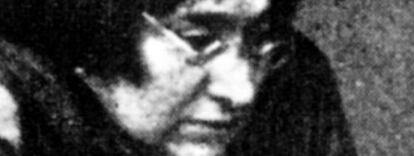María Blanchard documentary opens new angle on neglected Cubist artist
Two major exhibitions to commemorate 80th anniversary of artist’s death.

2012 is not the “Year of María Blanchard,” but almost. After spending a long time in the shadow of Juan Gris, Jacques Lipchitz and Diego Rivera, the painter from Santander has — thanks to a new documentary — for the first time been placed among the great names of the turn-of-the-century Parisian avant-garde.
Rue du Départ 26. Érase una vez París, directed by Gloria Crespo, reappraises Blanchard’s career and artistic merit within the Cubist movement. It is also being released in the same year that the Botín Foundation and the Reina Sofía Museum have programmed major exhibitions commemorating the 80th anniversary of the artist’s death.
“María Blanchard is a frontline figure,” says Crespo. “She was at the heart of that artistic moment and she had a personality of her own, even though she was treated unfairly by life and history.” The documentary tries to redress this wrong and rediscover an artist whose physical disability — she was a hunchback — conditioned her life and the way her work was consistently undervalued.
Crespo, a graphic editor at El PAÍS, studied fine arts and remembers that María Blanchard only ever got a brief mention “or was simply not mentioned at all.” It was then she had the idea of exploring the life of a woman who suffered tremendously because of her physical defect, yet had the courage to go to Paris, where she joined the avant-garde artists at a key moment in the history of art.
“She was a woman ahead of her time, who managed to find her place in a world of men and was modern simply by being herself, with no artifice,” says Crespo, who spent six years researching Blanchard’s figure and followed her trail from Cantabria to Paris, Mexico and Madrid. She found previously unseen material and was able to document that Blanchard showed one of her paintings at the Salon d’Antin, in 1916, where Picasso first presented Les Demoiselles d’Avignon in an exhibition in which Matisse and Modigliani also participated.
“Since then, Blanchard was there in her own right, together with the greats,” says the film director.
Crespo included images of an interview with Jean Cocteau in which the writer explains that those men and women were geniuses who revolutionized art for the sake of art itself, “without looking at anyone else.”
“That was Blanchard’s spirit,” says Crespo, adding that her peculiar treatment of color “humanized” Cubism. Blanchard also brought the Cubist influence to her later figurative work, creating a language of her own that made her a great artist who is just now being rescued from obscurity.
The interviewees include historians and art critics such as María José Salazar, the curator of the Blanchard shows this year; Carmen Bernárdez-Sanchís and Juan Manuel Bonet. There are also relatives of the artist and descendants of her close friends, such as the daughter of Diego Rivera, Guadalupe, who says Blanchard suffered because she fell in love with her father but he did not return this love.
“Paradoxically, her deformity allowed her to be accepted in this world of men, who saw her as a real artist.”
The documentary also shows that beauty was a refuge where Blanchard was able to exorcize her inner demons; it further explores her deep friendship with Juan Gris and the depression of her later years, which led her to religious experiences before her eventual death in 1932.
Tu suscripción se está usando en otro dispositivo
¿Quieres añadir otro usuario a tu suscripción?
Si continúas leyendo en este dispositivo, no se podrá leer en el otro.
FlechaTu suscripción se está usando en otro dispositivo y solo puedes acceder a EL PAÍS desde un dispositivo a la vez.
Si quieres compartir tu cuenta, cambia tu suscripción a la modalidad Premium, así podrás añadir otro usuario. Cada uno accederá con su propia cuenta de email, lo que os permitirá personalizar vuestra experiencia en EL PAÍS.
¿Tienes una suscripción de empresa? Accede aquí para contratar más cuentas.
En el caso de no saber quién está usando tu cuenta, te recomendamos cambiar tu contraseña aquí.
Si decides continuar compartiendo tu cuenta, este mensaje se mostrará en tu dispositivo y en el de la otra persona que está usando tu cuenta de forma indefinida, afectando a tu experiencia de lectura. Puedes consultar aquí los términos y condiciones de la suscripción digital.
Últimas noticias
Maduro pleads not guilty before the federal court in New York: ‘I am still the president of Venezuela’
A new test can detect Alzheimer’s from a finger prick
UN team enters Sudanese city of El Fasher after paramilitary massacre: ‘It’s like a ghost town’
A recipe for resistance: Indigenous peoples politicize their struggles from the kitchen
Most viewed
- Gilles Lipovetsky: ‘If you want to live better and fall in love, take Prozac, don’t look to philosophy’
- Alain Aspect, Nobel laureate in physics: ‘Einstein was so smart that he would have had to recognize quantum entanglement’
- Alvin Hellerstein, a 92-year-old judge appointed by Bill Clinton, to preside over Maduro’s trial in New York
- Why oil has been at the center of Venezuela-US conflicts for decades
- Maduro’s downfall puts China’s relationship with Venezuela to the test








































